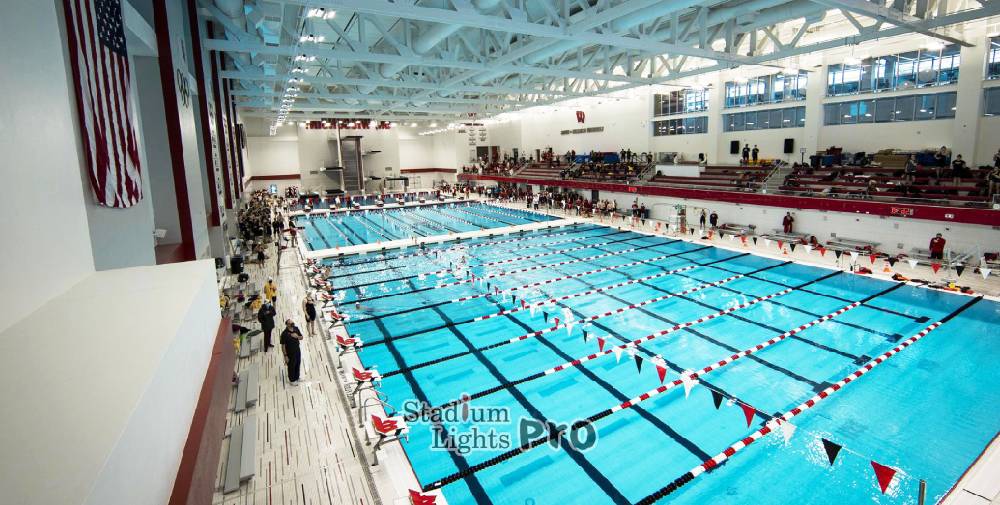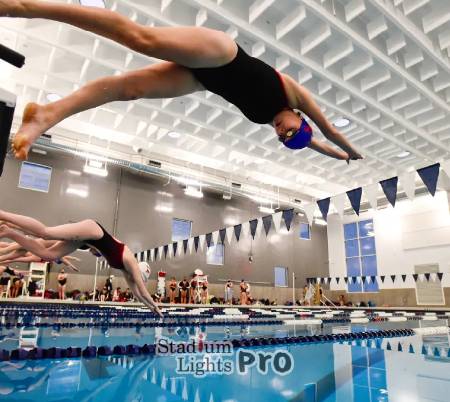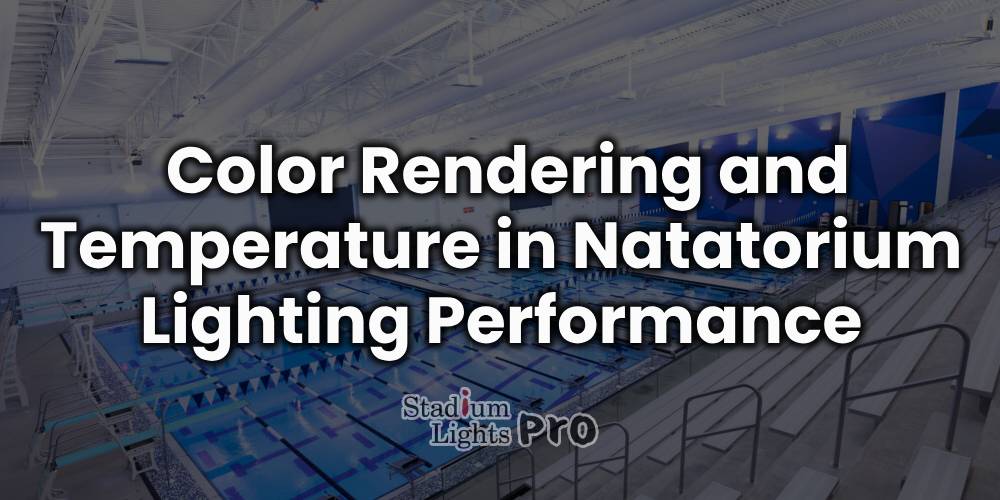Lighting a natatorium presents a unique set of challenges due to its reflective surfaces, moisture-rich air, and the specific tasks that occur within the space. Water acts as a mirror, bouncing light in unpredictable ways. The interplay between the ceiling, walls, and water surface can distort visibility if lighting is not thoughtfully executed. For swimmers, coaches, and spectators alike, clarity matters—not only for performance but also for a comfortable visual experience. Beyond brightness, the quality of light itself influences how well objects, people, and movement can be perceived.
Table of Contents
ToggleColor Rendering and Visual Perception
Color rendering describes how accurately a light source reveals the true colors of objects compared to natural daylight. In a natatorium, this aspect affects the visibility of lane markers, flags, swimwear, and even skin tone, all of which are used for navigation, coaching, and officiating during competitions. A higher color rendering index (CRI) provides more natural and consistent visibility throughout the facility.
When CRI is low, colors can appear dull or unnatural, which might hinder judgment in training or during swim meets. A CRI value above 80 is commonly considered sufficient for general environments, but natatoriums often benefit from higher ratings. With higher CRI lighting, referees can distinguish between swimmers’ strokes more clearly, and lifeguards can assess conditions in and around the pool with greater ease. Coaches, too, rely on accurate visuals to analyze form and movement, which contributes to athletic development.

Color Temperature and Its Psychological Effects
Color temperature, measured in Kelvin (K), influences the tone and feel of a lit environment. Warmer temperatures (around 2700K to 3500K) create a cozy, ambient atmosphere, while cooler temperatures (4000K to 6500K) produce a more alert, energizing effect. For natatoriums, cooler color temperatures are usually selected to promote focus and visual sharpness.
Cool white lighting not only supports high-contrast visibility but also interacts well with the blue hues of pool water. This pairing enhances the perception of cleanliness and reinforces a sense of freshness. The right color temperature can subtly motivate swimmers, keeping them alert and engaged during training or competition. Moreover, cooler tones prevent the facility from feeling overly dim or yellowed, especially in spaces with minimal natural light penetration.
Interaction of CRI and Color Temperature
How CRI and Color Temperature Work Together
Color rendering and temperature do not operate in isolation. These two characteristics work together to determine how the light interacts with the environment, how colors are perceived, and how comfortable the space feels to its users. In a natatorium, where visual demands vary between swimmers, spectators, and staff, the combined effect of CRI and color temperature can influence both performance and perception.
A high CRI ensures that colors appear natural and true-to-life. When paired with a cool white temperature—often ranging between 4000K and 5000K—it produces a crisp, clean visual effect that brings out the contrast between the water, pool floor, lane dividers, and other visual cues. This helps swimmers stay oriented and aware of their surroundings. Coaches and officials also benefit from accurate color distinctions, allowing them to identify swim gear, recognize subtle movements, or spot fouls during competitive events.
This pairing is especially useful in environments where quick visual recognition is needed. Swim caps, often color-coded for team identification, become easier to distinguish under light that renders colors accurately. Underwater visibility is also improved when the light penetrates the surface cleanly and reveals true hues instead of distorting them. Even signage, often used for directing foot traffic or marking emergency exits, becomes more readable with consistent color accuracy.

Choosing the Right Balance
Despite their benefits, color temperature and CRI must be chosen with intent. Cooler temperatures can give a space a sterile, clinical feel if the light source has poor rendering qualities. In that case, even brightly lit areas might appear washed out or overly blue, resulting in eye strain and visual fatigue. This can be especially uncomfortable in a space like a natatorium where glare and reflected light already present challenges. On the other hand, warm color temperatures, while visually soothing in other settings, can create a yellowish cast that makes water appear murky or unclean. When color accuracy is low, the subtle variations in skin tones, water clarity, or pool surfaces may be lost.
Achieving the right balance between these two factors allows designers to enhance the user experience without resorting to excessive brightness. When the quality of light is high, even moderate light levels can create a perception of brightness and clarity. This can help reduce the overall energy consumption of the facility, since lighting systems won’t need to be pushed to their maximum output to achieve visibility goals. It also prolongs the lifespan of fixtures and controls heat buildup—an added bonus in environments where temperature and humidity are already elevated.
Leveraging Technology for Greater Flexibility
Modern lighting technologies offer more flexibility than ever in adjusting CRI and color temperature together. LED systems, in particular, can be tuned for both qualities at the time of installation or even dynamically throughout the day. This opens the door to customized lighting scenes—such as cooler, higher-CRI light for competitions and slightly warmer tones for casual use or early morning training sessions. Some systems also allow automated transitions based on occupancy or scheduling, ensuring that the natatorium remains visually consistent and adaptive to user needs without manual intervention.
Ultimately, the interaction between CRI and color temperature shapes the atmosphere and usability of a natatorium. A high-performance aquatic facility is not just well-lit—it’s visually intuitive. When the quality of light supports natural color perception and maintains a comfortable temperature tone, the entire environment becomes more functional and visually engaging. This fosters a better experience for all, whether someone is swimming laps, officiating a race, or simply enjoying the view from the stands.
Impact on Athlete Performance and Spectator Experience
The Role of Lighting in Athlete Performance
 Lighting affects more than just visibility; it influences mood, focus, and the sense of space. In a natatorium, where precision, rhythm, and split-second timing matter, the quality and distribution of light play a powerful role in shaping an athlete’s performance. Swimmers depend heavily on spatial orientation, and being able to clearly perceive lane lines, backstroke flags, wall tiles, and movement in adjacent lanes supports a more intuitive relationship with their environment. Accurate lighting helps them stay in line, manage turns, and time strokes more effectively. Even subtle shifts in brightness between lanes or areas of the pool can disrupt concentration or cause disorientation during critical moments.
Lighting affects more than just visibility; it influences mood, focus, and the sense of space. In a natatorium, where precision, rhythm, and split-second timing matter, the quality and distribution of light play a powerful role in shaping an athlete’s performance. Swimmers depend heavily on spatial orientation, and being able to clearly perceive lane lines, backstroke flags, wall tiles, and movement in adjacent lanes supports a more intuitive relationship with their environment. Accurate lighting helps them stay in line, manage turns, and time strokes more effectively. Even subtle shifts in brightness between lanes or areas of the pool can disrupt concentration or cause disorientation during critical moments.
Visual Consistency for Competitive Swimmers
For competitive swimmers, especially in meets held under pressure, visual consistency allows them to move through the water with confidence. Good lighting reduces hesitation and cognitive load, allowing athletes to focus fully on technique and performance. Start blocks, timing touchpads, and visual cues from coaches or officials are all easier to process under lighting conditions that avoid glare, shadows, or color distortion. The quick, explosive movements at race starts or the fine motor adjustments during a flip-turn become clearer and more responsive when light reveals detail instead of flattening it.
Impact of Lighting on Training Environments
Training environments benefit equally from thoughtful lighting. Swimmers who practice in a visually stable and clear setting are more likely to develop proper alignment, breathing rhythm, and body control. Coaches can more effectively assess technique, correct stroke form, and provide feedback when they can see the swimmer’s body position and motion in true color and contrast. The visual clarity offered by balanced CRI and color temperature creates a feedback loop that enhances both instruction and athletic improvement.
Enhancing the Spectator Experience
Spectators, too, are part of the natatorium experience, and their comfort and engagement are shaped by how well the lighting supports visibility and ambience. From family members cheering on a young swimmer to officials tracking strokes and splits, clear visual access to the pool enhances connection to the event. Lighting that delivers uniform brightness across water surfaces, deck areas, and seating sections ensures that all spectators, regardless of where they’re seated, have a fair and uninterrupted view of the competition.
Color Clarity and Event Energy
Color clarity contributes to the energy and drama of the event. The movement of brightly colored swim caps, the sparkle of water droplets under overhead beams, and the dynamic interplay of athletes’ movements are all more visually striking under lighting with a higher color rendering index. Cool white tones add a sense of vibrancy and freshness, contributing to the feeling of being in a fast-paced, professional environment. When light is dim, uneven, or overly yellow, the excitement of the competition can feel diminished, and the event becomes harder to follow—especially for those relying on visual cues to keep up with multiple heats or swimmers.
The Comfort of Spectators
Comfort is just as important as clarity. Spectators attending long meets, especially in warm and humid pool environments, are more susceptible to visual fatigue if lighting is too harsh or inconsistent. Flicker, glare, or poor contrast can lead to headaches or eye strain over time. A lighting setup that maintains consistent tone and brightness helps ease the experience, making it more inviting for those staying for hours at a time. This is especially relevant for families, young children, and elderly guests, who may be more sensitive to lighting discomfort.
The Atmosphere of a Natatorium
The entire ambiance of a natatorium changes when lighting supports rather than competes with the activity within the space. When designed with care, lighting becomes part of the event itself—it enhances the spectacle, defines the atmosphere, and shapes how people remember their experience. Whether it’s the athlete preparing for a personal best or a parent watching from the bleachers, quality lighting has the power to make every moment more vivid, immersive, and connected.
Safety and Supervision Considerations
In any aquatic facility, visibility directly supports supervision and emergency response. Lifeguards rely on quick visual assessments, both above and below the water’s surface. Shadows, glare, or unnatural coloration can interfere with judgment. When color rendering is accurate and temperatures are optimized for clarity, potential hazards are easier to detect.
Accurate lighting helps ensure compliance with pool safety regulations as well. Emergency equipment, floor markings, and exit signage should all be easily recognizable under ambient light. Enhanced visibility assists in crowd control and reduces the likelihood of accidents, particularly during busy periods or special events.
Design Integration with Architectural Features
A natatorium is often a large-volume space with high ceilings, glass panels, and a blend of wet and dry zones. Lighting must be designed to complement the geometry and materials of the structure. Color temperature affects how materials appear—cooler temperatures may highlight stainless steel or tile finishes, whereas warmer tones may soften wooden paneling or accent walls.
Lighting that supports architectural intent can elevate the aesthetic of the entire facility. Pools that double as community centers or host public events benefit from lighting that enhances visual appeal without compromising function. The interplay between light, water, and space can create a distinctive atmosphere that leaves a lasting impression.
Technology Trends in Pool Lighting
Modern natatoriums increasingly use LED systems, which offer flexible control over both color temperature and CRI. LED luminaires can be fine-tuned to specific outputs, and advanced fixtures may include dynamic tuning to adjust lighting throughout the day or for different events. Some systems incorporate sensors to automatically adjust lighting based on occupancy, ambient daylight, or pre-programmed scenes.
LED lighting also minimizes heat output, an added advantage in humid pool environments. With less thermal buildup, the HVAC systems face lower stress, contributing to overall energy savings. The long lifespan of quality LED fixtures also reduces maintenance requirements, especially for lighting mounted in hard-to-reach areas like over diving platforms or high ceilings.
Conclusion
The performance of lighting in a natatorium depends on more than brightness or fixture placement. The quality of light, shaped by its rendering ability and temperature, plays a quiet but influential role in how the space is experienced. When colors appear natural and tones align with the environment’s purpose, swimmers move with confidence, viewers stay engaged, and staff operate with clarity. Choosing the right combination of CRI and color temperature supports a balanced, visually comfortable atmosphere where function and design meet. As lighting technology continues to advance, designers have more tools than ever to achieve that harmony between performance and experience.

